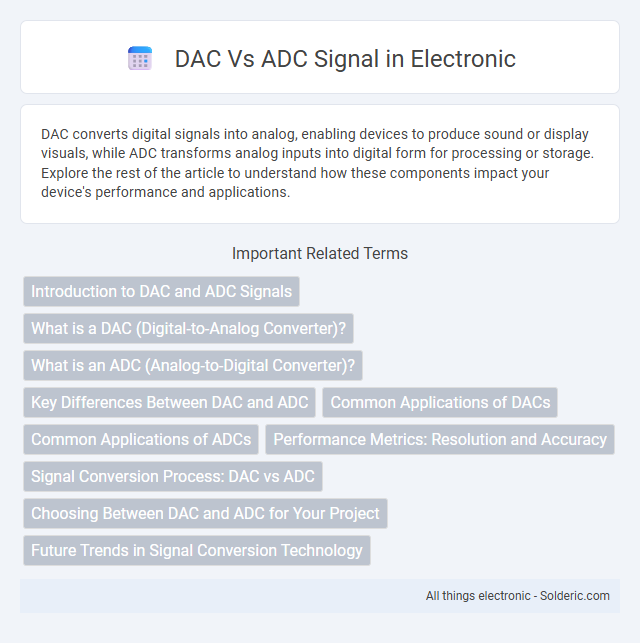DAC converts digital signals into analog, enabling devices to produce sound or display visuals, while ADC transforms analog inputs into digital form for processing or storage. Explore the rest of the article to understand how these components impact your device's performance and applications.
Comparison Table
| Feature | DAC (Digital-to-Analog Converter) | ADC (Analog-to-Digital Converter) |
|---|---|---|
| Function | Converts digital signals into analog signals | Converts analog signals into digital signals |
| Input | Digital data (binary) | Analog voltage or current |
| Output | Analog voltage or current | Digital code (binary) |
| Application | Audio playback, signal generation, control systems | Data acquisition, audio recording, sensor interface |
| Key Parameters | Resolution (bits), settling time, linearity | Resolution (bits), sampling rate, accuracy |
| Common Types | R-2R ladder, weighted resistor DAC, sigma-delta DAC | Successive approximation, flash ADC, sigma-delta ADC |
| Signal Domain | Digital - Analog | Analog - Digital |
Introduction to DAC and ADC Signals
Digital-to-Analog Converters (DACs) transform digital signals into continuous analog waveforms, enabling devices to produce sound, visuals, or other analog outputs. Analog-to-Digital Converters (ADCs) capture real-world analog signals and convert them into digital data for processing, storage, or analysis. Understanding the fundamental differences between DAC and ADC signals is crucial for optimizing your electronic systems in audio, communications, and instrumentation applications.
What is a DAC (Digital-to-Analog Converter)?
A DAC (Digital-to-Analog Converter) transforms digital signals, composed of binary code, into continuous analog signals essential for audio playback, video display, and sensor interfacing. This conversion enables your digital devices to interact with real-world analog systems by delivering smooth voltage or current outputs. High-resolution DACs enhance sound quality and precision in applications like music production, telecommunications, and instrumentation.
What is an ADC (Analog-to-Digital Converter)?
An ADC (Analog-to-Digital Converter) transforms continuous analog signals into discrete digital values, enabling microcontrollers and digital systems to process real-world inputs like temperature, sound, or light. It samples the input voltage at specific intervals, quantizes the signal into binary code, and represents the analog amplitude in a digital format suitable for computation. Understanding your device's ADC resolution and sampling rate is crucial for achieving accurate and reliable data conversion in your applications.
Key Differences Between DAC and ADC
DAC converts digital signals into analog signals that can be used by real-world devices, while ADC converts analog signals into digital data for processing by electronic systems. The resolution and sampling rate are critical parameters affecting the accuracy and quality of both DAC and ADC, with DAC focusing on signal reconstruction and ADC on signal digitization. Understanding these key differences helps you select the appropriate converter for applications such as audio processing, instrumentation, and communication systems.
Common Applications of DACs
DACs (Digital-to-Analog Converters) are essential in audio equipment for converting digital music files into analog signals that speakers can reproduce, ensuring high-fidelity sound quality. They are widely used in video playback devices to transform digital video data into analog signals compatible with older display technologies. You'll also find DACs in telecommunications systems where they convert digital voice data into analog signals for transmission over traditional phone lines.
Common Applications of ADCs
ADCs (Analog-to-Digital Converters) are widely used in digital signal processing systems, medical imaging devices, and telecommunications to convert analog signals into digital data for precise analysis. Common applications include audio recording, where ADCs translate sound waves into digital audio files, and sensor data acquisition in industrial automation enabling real-time monitoring and control. Their role is critical in digital oscilloscopes, radar systems, and instrumentation, providing accurate digital representation of physical signals.
Performance Metrics: Resolution and Accuracy
DACs and ADCs are critical components in digital signal processing, with resolution defined by the number of bits determining the smallest voltage step they can represent or detect. Accuracy in DACs is influenced by factors such as linearity, monotonicity, and default offset errors, while ADC accuracy depends on quantization error, signal-to-noise ratio, and integral non-linearity. High-resolution ADCs typically provide better accuracy in signal conversion, whereas precision DACs ensure faithful analog signal reconstruction, both essential for system performance optimization.
Signal Conversion Process: DAC vs ADC
The DAC (Digital-to-Analog Converter) transforms digital signals, typically binary data, into continuous analog waveforms, enabling digital devices to interact with real-world analog systems such as speakers and sensors. In contrast, the ADC (Analog-to-Digital Converter) samples analog signals at specific intervals, quantizing the amplitude into discrete digital values for processing, storage, or analysis by digital circuits. Both conversions rely on precise timing and resolution parameters, with DACs emphasizing smooth output reconstruction and ADCs focusing on accurate signal representation within defined bit depths and sampling rates.
Choosing Between DAC and ADC for Your Project
When choosing between DAC and ADC for your project, consider the signal direction: ADC converts analog signals to digital, essential for processing real-world inputs in microcontrollers and digital systems. DAC converts digital signals back to analog, crucial for audio output, control systems, and analog device interfacing. Your choice depends on whether you need to digitize analog signals or generate analog outputs from digital data.
Future Trends in Signal Conversion Technology
Emerging trends in signal conversion technology emphasize higher resolution and faster sampling rates for both DAC and ADC devices, driven by demands in 5G, IoT, and AI applications. Advanced materials such as GaN and SiC improve efficiency and thermal performance, while integration of machine learning algorithms enhances real-time signal processing accuracy. Your systems will benefit from these innovations by achieving lower latency and greater precision in digital-to-analog and analog-to-digital conversions, enabling more responsive and reliable electronic communication.
DAC vs ADC signal Infographic

 solderic.com
solderic.com